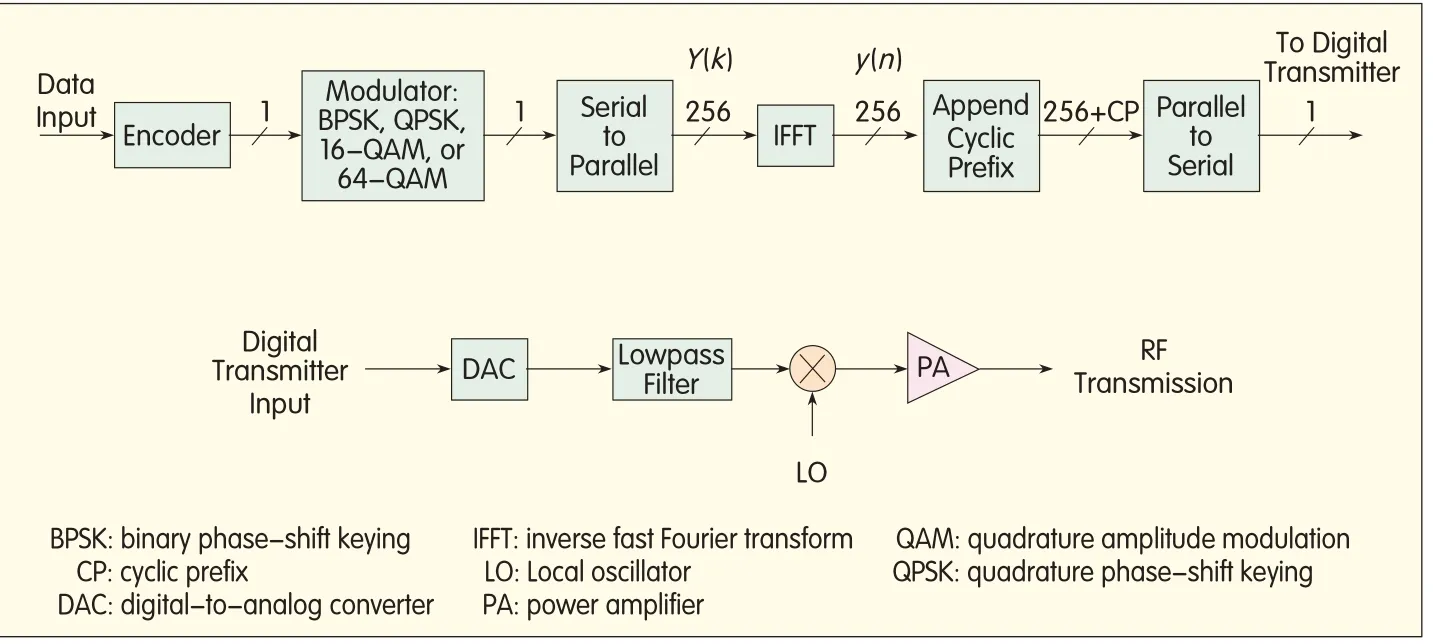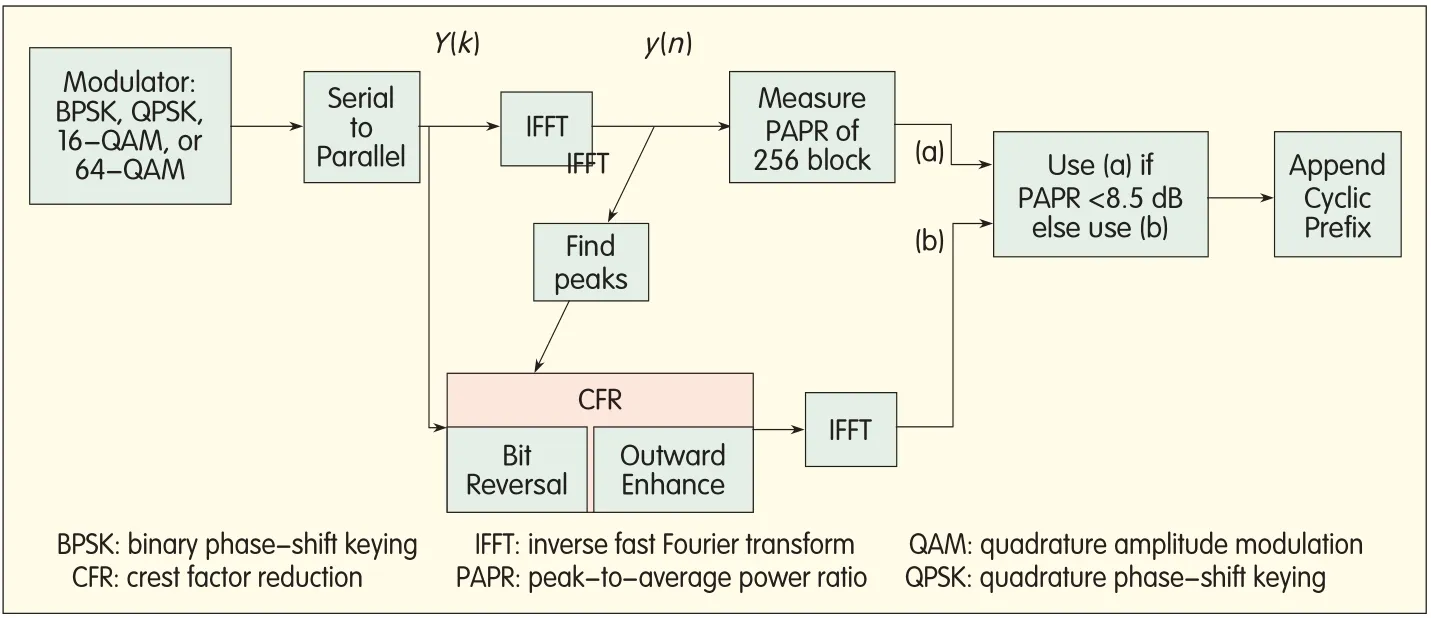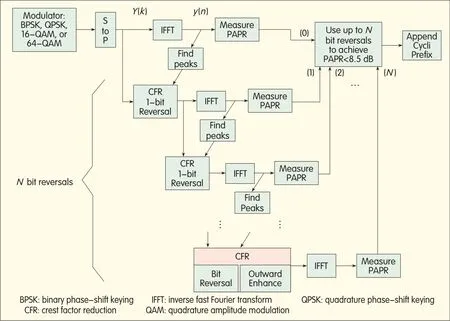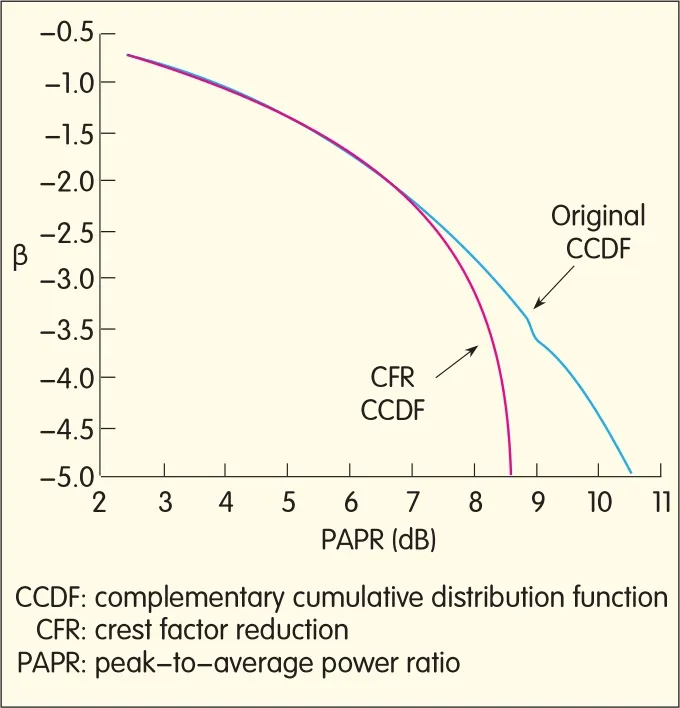Crest Factor Reduction for OFDM Using Selective Subcarrier Degradation
R.Neil Braithwaite
(Powerwave Technologies,Santa Ana,CA 92705,USA)
Abstract:This paper describes a crest factor reduction(CFR)method that reduces peaks in the time domain by modifying selected data subcarriers within an OFDM signal.The data subcarriers selected for modification vary with each symbol interval and are limited to those subcarriers whose data elements are mapped onto the outer boundary of the constellation.In the proposed method,a set of peaks are identified within an OFDM symbol interval.Data subcarriers whose data element has a positive or negative correlation with the set peak are selected.For a subcarrier with an outer element and a significant positive correlation,a bit error(reversal)is intentionally introduced.This moves the data element to the opposite side of the constellation.Outer elements on negatively-correlated subcarriers are increased in magnitude along the real or imaginary axis.Experimental results show that selecting the correct subcarriers for bit reversals and outward enhancements reduces the peak-to-average power ratio(PAPR)of the OFDM signal to a target value and limits in-band degradation measured by bit error rate(BER)and error vector magnitude(EVM).
Keyw ords:crest factor reduction;OFDM;PAPR;wireless communication system;digital transmitter
1 Introduction
O rthogonal frequency-division multiplexing(OFDM)waveforms can have large peak-to-average power ratios(PAPR).Crest factor reduction(CFR)reduces peaks at the expense of signal quality.Usually,degradation is distributed throughout the signal’s frequency bandwidth in the form of spectral leakage and in-band errors.However,because the OFDM signal is created in the Fourier domain,degradation can be concentrated to specific subcarriers(frequency bins of the FFT).
In the proposed method,CFRis used sparingly to bound the PAPRwhen transmitting at high power levels.This differs from the usual approach of maximizing PAPRreduction.The bound is met,and bit error rate(BER)is limited without deviating from the OFDM standard—for example,Worldwide Interoperability for Microwave Access(WiMAX)802.16[1].This peak power bound allows the power amplifier(PA)in the transmitter to be designed for greater power-added efficiency(PAE)[2].It may be necessary to enforce a second PAPRbound if the dynamic range of the digital-to-analog converter(DAC)cannot prevent clipping for allpossible signals.
The remainder of this introduction describes OFDM signal generation as well as the subcarrier phase alignments that create peaks.Section 2 contains a review of CFRmethods.Section 3 introduces new CFRmethods for intentionally degrading selected subcarriers whose data elements are correlated(phase aligned)with the peaks of the OFDM signal.Section 4 contains experimental results that show a WiMAXsignalcan be crest-factor reduced to a target PAPRby introducing an acceptable amount of in-band degradation.This degradation is measured by the BERand error vector magnitude(EVM).
1.1 OFDM Transmit Overview
Creation of an OFDM symbol for radio frequency(RF)transmission is shown in Fig.1.The symbol is part of a data stream that has been 1)encoded,2)modulated,3)converted from serial to parallel as a 256 sample block,4)converted to the time domain using an inverse fast Fourier transform(IFFT),5)extended using a cyclic prefix(CP)to 256+CPsamples,and 6)converted back into a serial data stream.The data stream is then converted from DAC,lowpass filtered,up-converted to RF,then amplified by a PA.The signals Y(k)and y(n)are important for the crest factor method presented in this paper.
These symbols correspond to the Fourier domain and time domain data blocks,respectively,of the OFDM symbol.

▲Figure 1.RFtransmission of one OFDMsymbol[3].
The encoding includes coders and interleavers to allow for error correction at the receiver.The modulator allows rate changes,and the rate is selected according to the received signal-to-noise ratio(SNR)and BERat the receiver.The rates from lowest to highest are binary phase-shift keying(BPSK),quadrature phase-shift keying(QPSK),16-quadrature amplitude modulation(16-QAM),and 64-QAM.In the serial-to-parallel conversion,a frequency domain representation is created,and the data elements are assigned to different subcarriers of the OFDM signal.The IFFTtransforms the data from the frequency domain to the time domain.The cyclic prefix is a copy of the tail of the time domain block and is appended to the beginning of the time domain block.The cyclic prefix protects against intersymbol interference(ISI)caused by multipath RFpropagation.
Within an OFDM symbol,the subcarriers may be data subcarriers,pilot subcarriers,or null subcarriers.No data elements are mapped onto the null subcarriers,which include the outer guard-band frequencies and the DC subcarrier.The pilots are BPSK-modulated and assigned to specific subcarriers.The remaining subcarriers are used for data transmission,which may be modulated using BPSK,QPSK,16-QAM,or 64-QAM.
The OFDM-transmitted signal is a sequence of symbols sent as a down-link(DL)subframe.This subframe comprises a preamble,frame control header(FCH),and DL bursts.QPSK is used for the preamble and BPSK for the FCH.BPSK,QPSK,16-QAM,or 64-QAM(except for the BPSK pilots)is used for the DL bursts.
The preamble and FCH are sent first,and the DL bursts are sent in order of the modulation rates(lower rates are sent first).
The OFDM symbol at the output is a time-domain data sequence.Although the individual data subcarriers are transmitted using simple modulation mappings,the magnitude in the time domain varies significantly.This is due to the IFFToperation that forms each time-sample from a sum of 200 random-phase variables(56 of the 256 subcarriers are null subcarriers).Phase alignment of subcarriers in the frequency domain results in large peaks in the time domain.
Peak-forming phase alignment in the frequency domain varies according to the position of the peak after the IFFT within the time block.A peak at time tpeakwithin the interval t=[0,255]is maximized by the following subcarrier phases:

subcarrier frequency index(DC=0),andθ(tpeak)is the phase of the complex time sample at tpeak.
The magnitude of the subcarriers also has an effect on peaking.Although the magnitude is constant for BPSKand QPSK,it varies between constellation elements for 16-QAM and 64-QAM.Higher magnitudes are found at the outer elements of the 16-QAM and 64-QAM constellations.As a result,it can be assumed that many of these outer constellation elements are present in the data subcarriers when a large peak appears in the time domain.
2 Crest Factor Reduction
Large peaks cause problems because PAs become less efficient as the PAPRof the RFsignal increases.Limiting the PAPRis necessary for a more efficient transmitter design.This process is called CFR.Past CFR methods for OFDM signals include clip and filter,partialtransmit sequence(PTS),selective mapping(SLM),tone reservation,and constellation extension.The following is a summary of these CFRmethods and their suitability for OFDM signals.
The direct CFRmethod involves clipping peaks of the time signal y(n)when they exceed a specified level,L.The clipped signal yclip(n)is

The excess peak waveform ypeaks(n)becomes

Clipping moves the constellation elements from their assigned positions.The difference between the actualand assigned positions in the IQ space is called the constellation error or EVM.The allowable relative constellation error for WiMAX,averaged over subcarriers,frames,and packets,depends on the rate modulation where the most difficult specification is-31.0 d B for the 3/4 rate 64-QAM.Clipping tends to distribute excess peak energy over the 256 subcarriers,including the null and pilot subcarriers.As well as EVM limits on the data subcarriers,there are also limits on spurious emissions and adjacent channel leakage ratio(ACLR).These limits are specifically for the null subcarriers within the guard-band frequencies.The energy from the clipped peaks must be constrained to reside primarily on the in-band subcarriers.
Filtering attenuates the excess peak energy present in the null subcarriers(except for the DCsubcarrier).That is,

where h(τ)is a filter kernel.The crest-factor-reduced signal being transmitted,denoted yCFR(n),becomes

whereαis a scaling term used to controlthe EVM introduced by the CFR[4],[5].In some clip and filter implementations[6],the excess peak waveform ypeaks(n)is replaced by a sequence of delta functions.Each delta function is located at a peak and assigned a magnitude and phase that match the excess value of the peak.This sequence is filtered using(4).
Usingαin(5)for controlling EVM of OFDM signals is not effective because the EVM limit varies according to the function of the subcarrier and the rate modulation of the data(BPSK,QPSK,16-QAM,or 64-QAM).It is beneficial for the receiver to have accurate pilot information,which means the CFR-induced EVM should be zero for pilot subcarriers.Multiaccess OFDM,such as OFDMA and LTE,may have different rate modulations on different subcarrier blocks.Because the allowable EVM is larger for BPSK and QPSK than for 16-QAM and 64-QAM,some researchers[7]convert the excess peak signal back into the frequency domain and apply the filtering and rate-dependent EVM control by weighting the subcarriers.
The result is then converted back into the time domain to produce the desired Δy(n)and yCFR(n).
The EVM control for a data subcarrier depends on the modulation type.CFR attempts to introduce EVM on data subcarriers to reduce peaks without increasing the BERat the receiver.Thus,QPSK allows more EVM than 64-QAM because the distance between neighboring points in the constellation is greater.However,some researchers[8]have exploited the fact that points on the outer boundary of the constellation have no neighbors in the outward-expanding direction.As a result,EVM need not be limited in the outward direction because it does not cause bit errors at the receiver.Outward expansion is also used in the proposed CFRand is discussed in section 3.
In a different class of CFRmethods,CFRdisrupts the subcarrier phase alignments that create peaks.These methods include partialtransmit sequence(PTS)[9]-[11]and selective mapping(SLM)[12].The subcarriers are multiplied by a set of different phase-shift vectors that produce a set of potential time sequences.The time sequence with the lowest PAPRis transmitted.Information about the phase-shift vector used must be sent to the receiver to allow demodulation.
This is considered a disadvantage of the method.A PTSmethod specifically for LTEand not requiring the phase-shift vector to be sent to the receiver is described in[13].Neither PTSnor SLM is used in the proposed CFRmethod.
A third CFRmethod involves reserving some of the subcarriers as peak-reducers;that is,the reserved subcarriers do not carry any data.This method is called tone reservation[14],[15].Once a peak is detected in the time domain,the magnitudes and phases of the reserved subcarriers are selected to reduce the peak.Unfortunately,data throughput is reduced because fewer data subcarriers are available.It is possible to use tone reservation as a form of clip and filter with EVM control.The EVM is set to zero for all data subcarriers that are not reserved for peak reduction.
The scale factor,α,may have to be increased above unity for such an implementation in order to compensate for the sparseness of the reserved subcarriers in the frequency domain.Reserved tones are not used in the proposed CFRmethod.
A fourth CFRmethod involves altering the constellation mapping so that elements are not unique.This is referred to as constellation extension[16].A redundant mapping of input bits is used so that opposing points on the constellation,dIQand-dIQ,represent the same data at the receiver.The advantage of constellation extension is thatπradian phase shifts can be introduced onto some of the subcarriers with the goalof disrupting peak-forming phase alignments.The downside of this method is that one bit is lost in the constellation mapping,which reduces throughput for QPSK,16-QAM,and 64-QAM to 1/2,3/4,and 5/6 of the originalvalue,respectively.Also,the Gray code mapping specified in the standard must be abandoned.
The proposed CFRmethod similarly introduces large phase shifts onto selected subcarriers;however,the phase shifts are applied to the standard Gray code mapping instead of using the redundant constellation mapping already described.
3 Proposed CFR Method
The proposed CFRmethod does not alter the WiMAX(or other OFDM)standard nor does it require additional information to be sent to the receiver.
The accuracy of the null and pilot subcarriers is preserved by restricting constellation errors to selected data subcarriers.CFRmodifications are applied only to subcarriers whose data elements are mapped onto the outer positions of the constellation.For BPSK and QPSK,the outer elements include the entire constellation.For 16-QAM and 64-QAM,there are 12(of 16)and 30(of 64)outer elements,respectively.
The outer elements have special properties in terms of constellation errors and BER.These properties are exploited in the proposed CFRmethod.
In a 16-QAM constellation,the IQ mapping and decision boundaries used by the receiver define the relationship between constellation errors and BER.The 16-QAM mapping is a Gray code(Fig.2).Also shown in Fig.2 are the decision boundaries of the receiver.It is of interest to determine a)the largest constellation error that can be tolerated without causing a bit error,and b)the largest constellation error caused by a single bit reversal.
The number of bit reversals between the actual and received elements is referred to as the Hamming distance.

▲Figure 2.16-QAMconstellation with Gray code mapping and decision boundaries.Outer elements can have differentconstellation errors for Hamming distance=1.
The largest constellation error that can be tolerated without causing a bit error depends on the position of the data element.A single bit error occurs when the constellation error causes the received element to cross one of the horizontal or vertical boundaries.The distance between an interior element and the closest boundary isΔ/2;however,this allowable error,which includes additive noise,is shared between the transmitter,receiver,and propagation channel.For the outer elements,there is at least one direction where no decision boundary exists:the outward direction away from either the Iaxis or Q axis(depending on the position within the constellation).At the corner elements,there are two directions unconstrained by decision boundaries.Intentionally increasing the constellation errors for outer elements in these unconstrained directions does not increase the BER[6].
To determine the largest constellation error caused by a single bit reversal,we need to look at the Gray code mapping.Neighboring elements in the horizontal and vertical directions have a Hamming distance of one.If we assume the actual and received constellation elements differ by a Hamming distance of one,the constellation error for an interior point isΔ.For outer elements,a Hamming distance of unity can produce a constellation error of 3Δ(Fig.2).Thus,large constellation errors can be created from a single bit reversalon an outer element.
Using the CFRmethod,constellation errors are created.The proposed method concentrates the constellation errors on the data subcarriers that produce the least amount of BER.That is,the goalis to generate as much constellation error as necessary for the CFRwhile creating the minimum Hamming distance between the actual and received elements.Data subcarriers with outer constellation elements are ideal for CFR.
Two CFRmethods are possible:outward enhancement and bit reversal.
The former increases the I-or Q-component magnitude for alldata subcarriers that have an outer element and negative correlation to the peak.
The latter reverses the sign of the I-or Q-component for subcarriers that have an outer element and large positive correlation to the peak.Because sign reversal causes a bit error,it is used more sparingly than outward enhancement.
As wellas reducing the peak value,it is also important not to significantly increase the secondary peaks in the time block.To avoid enhancing secondary peaks,certain subcarriers cannot be used for peak reduction.Only subcarriers with a negative correlation to the primary peak and all secondary peaks are used for the outward enhancements.Only subcarriers with a positive correlation to the primary and secondary peaks are considered for bit reversal.The number of secondary peaks specified must be limited to avoid eliminating too many subcarriers from the CFRprocess.
The CFRmethod is shown in Fig.3.The OFDM system in Fig.1 is modified so that the PAPRis measured in the time domain,after the IFFTand before the addition of the cyclic prefix.If the PAPRis smallenough(less than 8.5 d B for example),the original OFDM data block is used for transmission.If the PAPRis too large,the CFROFDM data block is used.Before CFRis applied,the primary and secondary peaks are identified within the time block.The CFRmodule reduces the primary peak and does not increase the secondary peaks.CFRis applied in the Fourier domain.The CFRsignal is then converted to a time block using an IFFT.
The CFROFDM data block is not computed when the PAPRof the original signal y(n)is below 8.5 d B.
The CFRmodule is shown in greater detail in Fig.4.CFRuses the phase alignment profile described by(1)for each of the primary and secondary peaks.The phase alignment profile is cross-correlated with the real and imaginary components of the subcarriers containing outer elements.
The cross correlations for tpeak are

The peak is formed by the sum of many subcarriers.Because of the phase termθ(tpeak)in(1),subcarriers with positive cross-correlations contribute to the peak whereas those with negative cross-correlations attenuate the peak.Applying a bit reversal,that is,changing the sign of either Re{Y(k)}or Im{Y(k)})to a subcarrier,reverses the cross-correlation.A positive to negative change reduces the peak.Increasing the magnitude of either Re{Y(k)}or Im{Y(k)}for a subcarrier possessing a negative cross-correlation also reduces the peak.Thus,a coordinated effort to create or enhance the negative cross-correlation on many subcarriers results in effective CFR.

▲Figure 3.CFRSchematic[3].

▲Figure 4.CFRfor the case of N bit reversals per OFDMsymbol plus outward enhancement[3].
There is a risk that a secondary peak will increase in response to the CFRof the primary peak.It would be poor use of bit reversals and outward enhancements if the CFRtransformed a secondary peak into a primary peak.To prevent this,the cross-correlations are computed relative to the secondary peaks as well.The intersection of the sets of positively-correlated components for each peak is used as a pool of available subcarriers for a bit reversal.The available subcarrier possessing the largest positive correlation to the peak is selected.The intersection of the negatively-correlated components for each peak is also computed.The outward enhancement is applied to all the available subcarrier components from the negatively-correlated set.The enhancement is a scalar multiple of the original value,for example,1.05 Re{Y(k)}or 1.05 Im{Y(k)}.
In this approach,a secondary peak has a magnitude that is above a threshold defined as a fraction of the primary peak.The fraction is determined by the amount of peak reduction sought from the CFR.The potential increase in the secondary peak is directly related to the decrease in the primary peak.Currently,the target PAPRis set to 8.5 d B.When the original PAPRis greater than 8.5,9.2,or 9.7 d B,the fractional thresholds for secondary peaks are 0.85,0.8,and 0.75 of the primary peak,respectively.
These thresholds were obtained by experimentation.
Selecting too many secondary peaks can be problematic because the intersection of the correlated subcarrier component sets(Fig.4)may become a null set,preventing any CFR.To avoid this problem,the fractional threshold for secondary peaks is raised,if necessary,until the number of selected peaks is three or less.For these rare occurrences,the number of bit reversals is reduced to avoid excessively enhancing the secondary peaks,but this comes at the expense of increased PAPR.Thus,to limit the number of secondary peaks considered,it is sometimes necessary to increase the target PAPRfor a given block,even if this results in clipping at the PA.
Because a bit reversal typically reduces the peak by about 0.4 d B,it is necessary to specify additionalbit reversals for large peaks.The number of bit reversals for an OFDM symbolis 1,2,3,or 4 when the original PAPR exceeds 8.7,9.2,9.7,and 10.1 d B,respectively.There are two approaches to implementing N bit reversals when N>1.Either all N bit reversals are applied at once(Fig.4),or single-bit reversals are applied recursively N times(Fig.5).For N=0(PAPR<8.7 d B),only outward enhancement is used.
Single bit reversal applied recursively N times is shown in Fig.5.This approach requires additional IFFTs to be computed.Because the primary and secondary peaks are re-computed after each bit reversal,the fractional threshold for the secondary peaks is set to 0.85.Outward expansion is applied after the last bit reversal has been completed.
In addition to bit reversals and outward expansions,a third CFR approach can be used.In this approach,constellation error is distributed over all elements,not just the outer elements.The phase profiles for the primary and secondary peaks are multiplied by a scalar term and then added to the Fourier coefficients.This introduces constellation errors similar to clipping,except that the affected subcarriers are selected,which allows the pilot and null subcarriers to be transmitted without error.Because the phase profiles of the primary and secondary peaks have already been computed(Fig.4),the additional computational cost is minimal.The size of the scalar term controls the constellation error in this third part of the CFR,and the scalar term is typically selected to be small in value.That is,this is not the primary source of peak reduction.In the proposed CFR method,the third approach is used to assist with reducing the largest peaks.
The scale term is made to be an increasing function of the PAPRof the OFDM symbol.

▲Figure 5.CFRfor N bit reversals per OFDMsymbolplus outward enhancement using the recursive implementation[3].
In the CFRapproach shown in Fig.4,the cross-correlation is computed for allsubcarrier components associated with the primary and secondary peaks.If only bit reversals are used for CFR,the cross-correlation for the secondary peak need only be computed for the subcarrier components associated with the primary peak(Fig.6).This can be thought of as a serial implementation of a correlated subcarrier component search(Fig.4),which requires fewer computations on average because the set of available subcarrier components becomes smaller as subsequent secondary peaks are tested.
4 Results
The CFRapproach in Fig.4 is applied to a WiMAXDLsubframe comprising two QSPKsymbols for the preamble,one BPSKsymbol for the FCH,and 75 64-QAM payload symbols.The 64-QAM symbols contain BPSKpilot subcarriers.The ratio for the cyclic prefix is 0.125,which corresponds to 32 time samples for the 256 data blocks.The DLsubframe is repeated 20 times with random data sent on the data subcarriers.
BERassociated with the CFRis caused by the bit reversals only and does not account for the forward error correction(FEC)provided by the bit encoding.The EVM caused by the CFR is measured with

where E[]is expected value,and dIQand dCFRare the data elements within the IQ constellation space before and after CFR,respectively.EVM is measured in two ways:the first uses the original constellation data point for dIQ(n)whereas the second defines dIQ(n)as the nearest constellation point to dCFR(n).In the first way,in-band signal degradations associated with both the outward expansion and bit reversals are measured;in the second way,degradation associated with the outward expansion only is measured.
CFRhas a target PAPRof 8.5 d B.The PAPRis defined as


▲Figure 6.Serialimplementation of the correlated subcarrier component search,suitable for CFRusing bit reversals only[3].
where y(t)is the analog output signal after filtering.In practice,however,the PAPRis defined using the digital time domain signal y(n)and is based on the signalpower statistics rather than the absolute peak.The practical peak is the level Po,for which the signal power y(n)2has a 10βprobability of exceeding this peak.The complementary cumulative distribution function(CCDF)of y(n)2,in whichβis plotted as a function of Po,is a useful description of the signal.In this paper,two probability thresholds are selected for defining the signal peak:β=-4 and-5.

▲Figure 7.CCDFfor the originaland crest factor reduced WiMAXtime waveforms.The vertical axis represents the 10β probability thatthe signal power|y(n)|2 exceeds the level Po=PAPR*P ave,where P ave is the average signalpower.
The CCDFs of the original and crest-factor-reduced OFDM time sequences are shown in Fig.7.Using the 10-4probability threshold for the CFROFDM time sequence,PAPRis 8.42 d B,which is a reduction of 1.2 d B from the 9.62 d BPAPRof the original signal.Using the 10-5probability threshold,PAPRof the CFRand original OFDM time sequences are 8.56 d B and 10.54 d B,respectively.That is,CFR reduces PAPRby 2 d B when the 10-5threshold is used.The crest-factor-reduced waveform meets the target PAPRof 8.5 d B for the 10-4probability threshold,which is used more commonly in PA design than the 10-5threshold.
The BERintroduced by the CFRis 0.00019(327 bit reversals from 1730460 bits sent).The EVM,including the bit reversals,is 0.0725,which is high for 64-QAM.The limit for 3/4 rate 64-QAM is 0.0282.However,when using the easier measure that excludes the contribution from bit reversals,EVM is 0.0119.This EVM level is considered acceptable.Most of the EVM for this second measure is due to the outward expansion of the constellation,which does not increase BERat the receiver.
This approach does not involve trying to achieve the lowest CFR.Instead,a bounded CFRis created to ease the design of the PAand digital circuitry and to generate a low BER.With this type of CFR,90%of the CFRsymbols are transmitted without modification.For such pass-through cases,only the PAPRmeasurement is required,and no additional IFFTs are computed.
5 Conclusion
A CFRmethod that is suitable for WiMAXand other OFDM signals has been presented.Degradation associated with CFRis restricted to selected data subcarriers whose data elements are mapped onto the outer boundary of the IQ constellation.Subcarrier components correlated to the phase profiles of the primary and secondary peaks are identified for modification by outward expansions and bit reversals.The peak-to-average power for the WiMAX signal is reduced to a target level,and this allows the PA in the transmitter to be designed for high PAE.CFRis achieved with an acceptable amount of in-band BERand EVM degradation.
- ZTE Communications的其它文章
- Advances in Digital Front-End and Softw are RFProcessing:PartⅡ
- Frost&Sullivan Recognizes ZTE as 2011 LTEVendor of the Year
- ZTE Establishes Global Consumer Brand Ambitions in 2011
- Polyphase Filter Banks for Embedded Sample Rate Changes in Digital Radio Front-Ends
- Design of Software-Defined Down-Conversion and Up-Conversion:An Overview
- Practical Non-Uniform Channelization for Multistandard Base Stations

